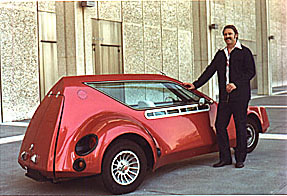 The Vigillante is a third generation design
of a vehicle originally developed in 1974. The first generation
design was called the TriVette, developed specifically as a response
to the first Arab Oil Embargo in late 1973.
The Vigillante is a third generation design
of a vehicle originally developed in 1974. The first generation
design was called the TriVette, developed specifically as a response
to the first Arab Oil Embargo in late 1973.
During this Arab Oil Embargo it became clear that we needed
to take a fresh look at basic transportation in this country.
We had become very fat and careless in the design of our basic
transportation vehicles. A study by an auto club at that time
found that 93% of the vehicles on the freeways 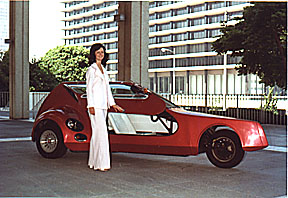 in
Southern California were being driven with only a single occupant,
the driver. It is extremely inefficient, both in terms of the
resources required to manufacture these vehicles, as well as
the fuel required to drive them, to use a 3,500 pound vehicle
to carry a 180 pound payload. In fact, it is absurd.
in
Southern California were being driven with only a single occupant,
the driver. It is extremely inefficient, both in terms of the
resources required to manufacture these vehicles, as well as
the fuel required to drive them, to use a 3,500 pound vehicle
to carry a 180 pound payload. In fact, it is absurd.
We did a systems analysis of the various alternatives that
could be used to address this issue. We looked at 4-wheel, 3-wheel,
and 2-wheel configurations. This analysis led to the selection
of a 3-wheel, single front tire configuration as the optimum
choice. This choice offers opportunities for very light weight,
excellent 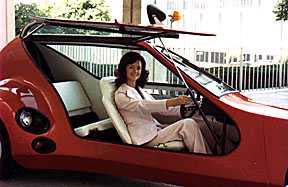 aerodynamics, excellent handling
and performance, and modest costs. The TriVette was designed
as a vehicle that was optimized to comfortably carry only the
driver most of the time, in a fully enclosed, all weather vehicle
with heater and optional air conditioning. That is exactly what
is needed to create a fuel-efficient commuter vehicle. A second
seat is provided for the occasional passenger, or as a place
for luggage, groceries, etc. The TriVette is classified as a
motorcycle under State and Federal laws.
aerodynamics, excellent handling
and performance, and modest costs. The TriVette was designed
as a vehicle that was optimized to comfortably carry only the
driver most of the time, in a fully enclosed, all weather vehicle
with heater and optional air conditioning. That is exactly what
is needed to create a fuel-efficient commuter vehicle. A second
seat is provided for the occasional passenger, or as a place
for luggage, groceries, etc. The TriVette is classified as a
motorcycle under State and Federal laws.
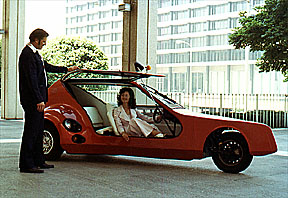 We were licensed by the State of California
as a motorcycle manufacturer, and the TriVettes were manufactured
in Ventura, California on a custom order basis from 1974 through
1978. The TriVettes met all applicable State and Federal motorcycle
standards as of the time of manufacture. Most of the TriVettes
used powertrains and other components from the Fiat 850's of
the late 1960's/early 1970's. These were excellent powertrains
that provided spirited performance and extremely good fuel economy
in a 1,140 pound vehicle. We typically got 50 mpg in heavy city
traffic and 65 mpg on the freeway. Also, because of the
We were licensed by the State of California
as a motorcycle manufacturer, and the TriVettes were manufactured
in Ventura, California on a custom order basis from 1974 through
1978. The TriVettes met all applicable State and Federal motorcycle
standards as of the time of manufacture. Most of the TriVettes
used powertrains and other components from the Fiat 850's of
the late 1960's/early 1970's. These were excellent powertrains
that provided spirited performance and extremely good fuel economy
in a 1,140 pound vehicle. We typically got 50 mpg in heavy city
traffic and 65 mpg on the freeway. Also, because of the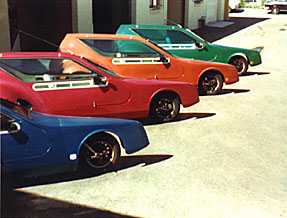 ir light weight and excellent balance, they
were a lot of fun to drive.
ir light weight and excellent balance, they
were a lot of fun to drive.
Road Test magazine tested a TriVette and published
an article in the January, 1976 issue. Their numbers show that
the TriVette reached .77 lateral "g" on the skidpad
using Goodrich T/A street tires. Comparison with other vehicles
in the review chart attached to the article shows that the TriVette
actually outcornered a Corvette of that time by 10%! It also
outcornered an Alfa Romeo Alfetta GT, a BMW 530i, a Fiat X1/9,
a Lotus Elite, and a Porsche 911S--pretty spectacular handling
for a 3-wheeled vehicle, which many people consider to  be inherently unstable.
Later testing by the Department of Transportation in 1980 determined
that the TriVette had a theoretical tip-over limit of 1.28 lateral
"g", or a .5 lateral "g" safety margin over
what the tires could deliver. That means the TriVette will slide
long before it reaches the tip-over limit. It also had the quickest
transient response that they had tested.
be inherently unstable.
Later testing by the Department of Transportation in 1980 determined
that the TriVette had a theoretical tip-over limit of 1.28 lateral
"g", or a .5 lateral "g" safety margin over
what the tires could deliver. That means the TriVette will slide
long before it reaches the tip-over limit. It also had the quickest
transient response that they had tested.
Many previous 3-wheel vehicle designs have typically been
oriented toward very low performance applications. Their physics
were not suitable for high performance applications, but the
TriVette demonstrated that with the proper physics, 3-wheeled
vehicles can be designed to have excelle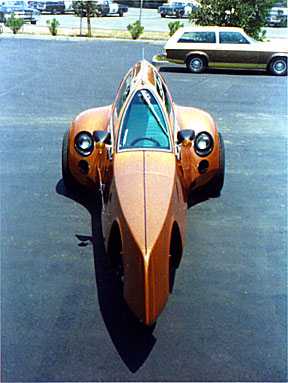 nt
handling. This is also what made them so quick and agile and
fun to drive in traffic. Also, the aerodynamics generated large
down forces, so the stability increased as the speeds increased.
The physics of high performance 3-wheeled vehicles requires that
the center of gravity needs to be close to the two tires that
can handle transverse cornering loads. The height of the center
of gravity must also be kept low to control transverse weight
transfer during cornering, as well as fore/aft weight transfer
during acceleration and braking. The physics is similar to the
careful weight and balance calculations that must be used when
designing light aircraft. Also, like in light aircraft design,
the highly variable loads of fuel and a passenger must be located
close to the center of gravity so they will have minimal effect
on the handling as those loads vary.
nt
handling. This is also what made them so quick and agile and
fun to drive in traffic. Also, the aerodynamics generated large
down forces, so the stability increased as the speeds increased.
The physics of high performance 3-wheeled vehicles requires that
the center of gravity needs to be close to the two tires that
can handle transverse cornering loads. The height of the center
of gravity must also be kept low to control transverse weight
transfer during cornering, as well as fore/aft weight transfer
during acceleration and braking. The physics is similar to the
careful weight and balance calculations that must be used when
designing light aircraft. Also, like in light aircraft design,
the highly variable loads of fuel and a passenger must be located
close to the center of gravity so they will have minimal effect
on the handling as those loads vary.
The primary reasons for selecting the single front tire, two
rear tire configuration for the TriVette (vs. the single rear,
two front tire configuration) are improved performance and handling.
During maximum a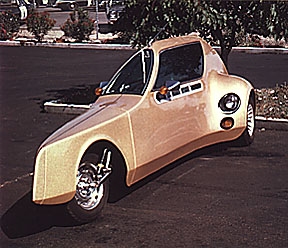 cceleration, weight is transferred
off the front tire and on to the rear drive tires. That increases
the percentage of the total vehicle weight on the drive tires,
and increases the maximum acceleration capability. The Turbo
TriVettes had enought thrust that they could momentarily jerk
the front tire off the ground, but careful weight and balance
calculations ensured that it could not be held off the ground.
Sufficient weight remained on the front tire to provide steering
control during maximum acceleration. This provides nearly the
acceleration capability of an all-wheel drive design, but without
the cost, complexity, power consumption, and weight of all-wheel
drive.
cceleration, weight is transferred
off the front tire and on to the rear drive tires. That increases
the percentage of the total vehicle weight on the drive tires,
and increases the maximum acceleration capability. The Turbo
TriVettes had enought thrust that they could momentarily jerk
the front tire off the ground, but careful weight and balance
calculations ensured that it could not be held off the ground.
Sufficient weight remained on the front tire to provide steering
control during maximum acceleration. This provides nearly the
acceleration capability of an all-wheel drive design, but without
the cost, complexity, power consumption, and weight of all-wheel
drive.
During maximum braking, weight is transferred from the rear
tires to the front tire. At maximum braking, the TriVet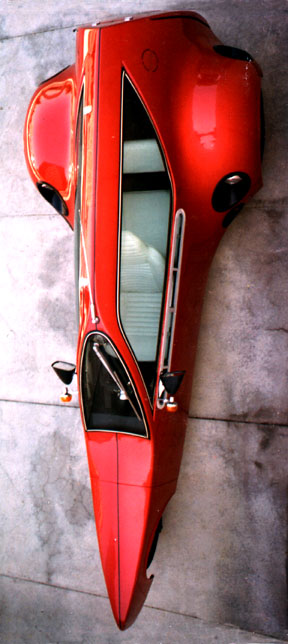 te ends up with approximately 1/3 of the
weight on each tire. Again, the heigth of the center of gravity,
the fore/aft location of the center of gravity, the wheelbase,
and other factors are carefully calculated to achieve this result.
Even in a full lockup stop on wet or slick pavement in a corner,
the TriVette will not spin. That's because more than half of
the braking is still being done by the rear tires behind the
center of gravity, so the vehicle is in a dynamically stable
position. The TriVette will outbrake even high performance conventional
vehicles, particularly on slick surfaces. This design also allows
a very light static loading on the single front tire, so a very
quick 12 to 1 ratio can be used without power steering--again,
saving cost, complexity, power consumption and weight. The forces
are so light that it can be turned easily with a small steering
wheel at rest for parking and requires only two fingers to steer
on the freeway. This design also makes possible a front suspension
design that has no bump steer, and one which can turn sharply
enough to provide a very small turning circles with a long wheel
base.
te ends up with approximately 1/3 of the
weight on each tire. Again, the heigth of the center of gravity,
the fore/aft location of the center of gravity, the wheelbase,
and other factors are carefully calculated to achieve this result.
Even in a full lockup stop on wet or slick pavement in a corner,
the TriVette will not spin. That's because more than half of
the braking is still being done by the rear tires behind the
center of gravity, so the vehicle is in a dynamically stable
position. The TriVette will outbrake even high performance conventional
vehicles, particularly on slick surfaces. This design also allows
a very light static loading on the single front tire, so a very
quick 12 to 1 ratio can be used without power steering--again,
saving cost, complexity, power consumption and weight. The forces
are so light that it can be turned easily with a small steering
wheel at rest for parking and requires only two fingers to steer
on the freeway. This design also makes possible a front suspension
design that has no bump steer, and one which can turn sharply
enough to provide a very small turning circles with a long wheel
base.
The long wheel base provides an excellent ride for the driver, who sits in the middle of the wheelbase. It also provides excellent high speed stability. The long wheelbase does not cost anything in transient response, however, because of the very low mass on the front end and the very quick steering ratio. In fact, the front tire literally goes wherever you point it, even at the limit of adhesion on a skidpad. The transient response of the front end is so quick that it is easy, even for a novice, to stay ahead of the back end where most of the mass is concentrated. The physics of the TriVette design result in a very stable, quick and nimble handling vehicle.
With this kind of handling, it was not surprising that customers began ordering TriVettes with stronger motors. We produced some Turbo TriVettes with approximately 220 horsepower turbo motors. The weight was still 1,140 pounds. This results in a street legal vehicle with 5.2 pounds per horsepower, or about 1/2 of that for a Corvette or other high-performance street vehicle. These vehicles would run 0 to 60 mph in 3.5 seconds and would run the 1/4 mile in 10.4 seconds at 140 mph. Stability and directional control at 140 mph was phenomenal.
The Turbo TriVette got the attention of the California Highway Patrol office located next to our facility in Ventura, California. They were looking for a high-speed pursuit vehicle that they could use to quickly run down the kids in their hot Camaros and Mustangs. The shorter the chase, the less the public is endangered. Their smoged Dodge Diplomats with a light bar were limited to 105 mph, and their motorcycles were also limited to 105 mph due to a problem with high speed wobble. This led to a design study funded by a grant from the National Science Foundation for a high-speed pursuit vehicle that would be able to reach 160 to 165 mph. This design was the second generation design. A brochure titled "Specification - Municipal Personal Transit Vehicle" was published from this study.